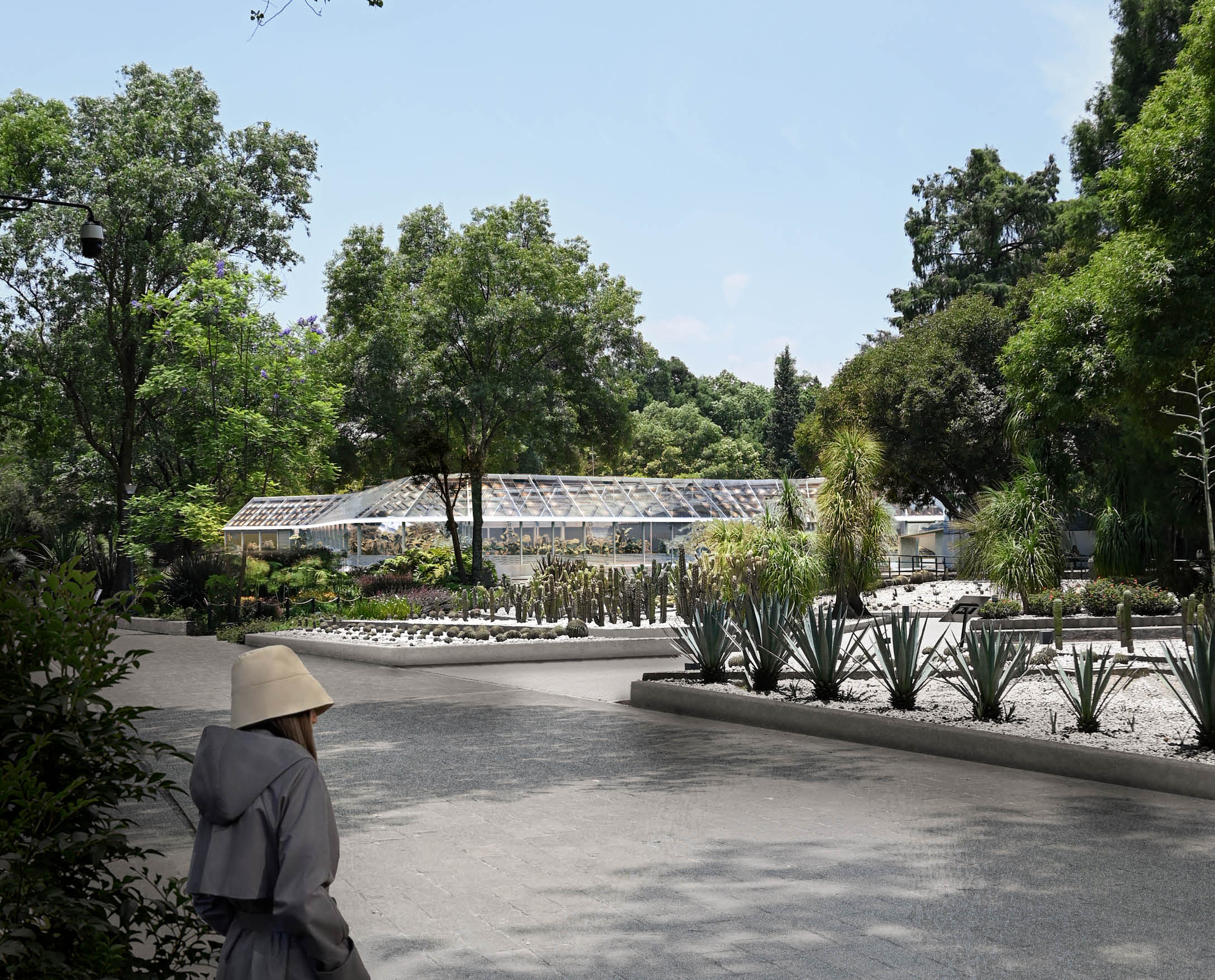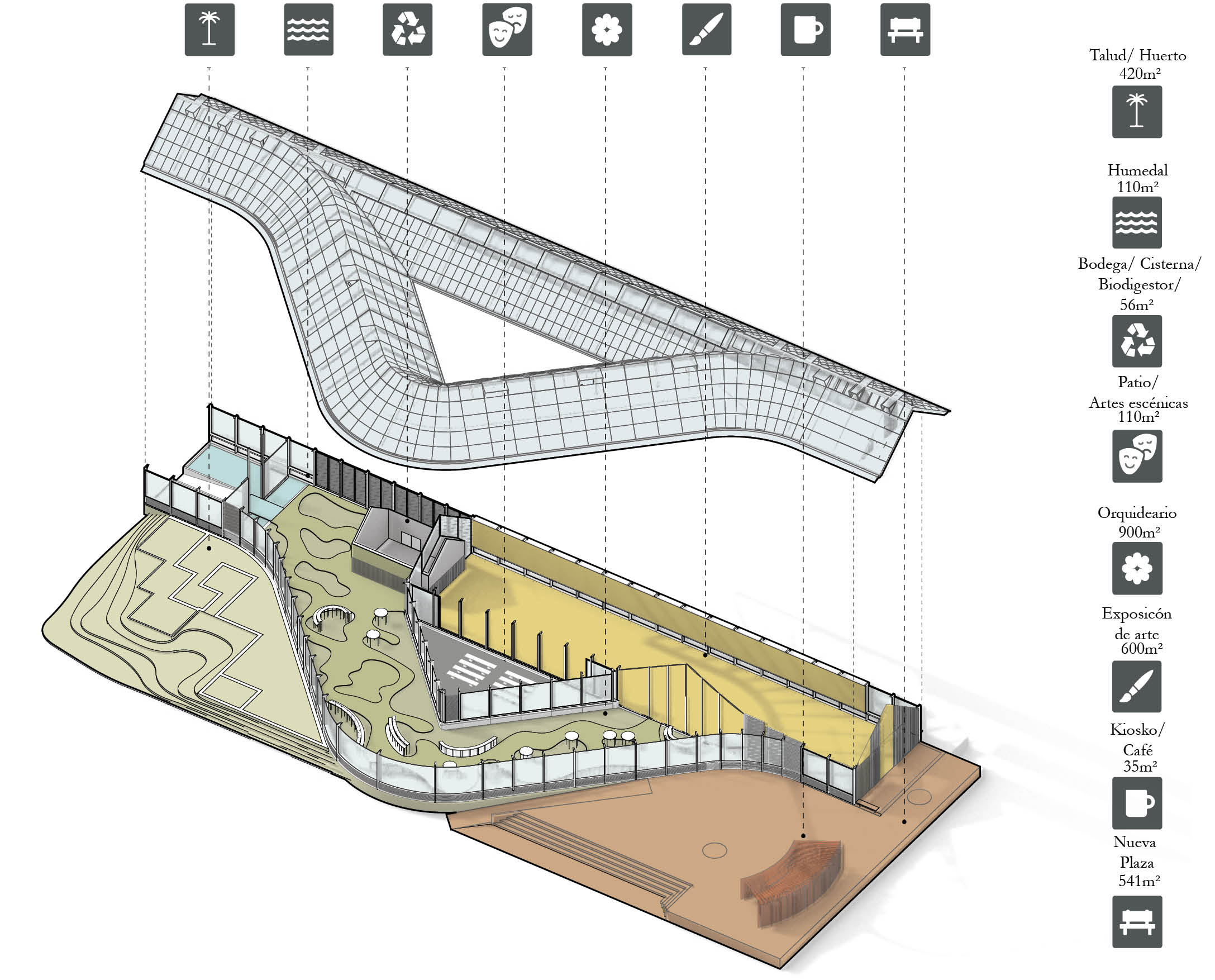Experimental
2022
Ciudad de México
About "Nuevo Pabellón Naturaleza y Cultura"
The new "Pabellón Naturaleza y Cultura" in Chapultepec Forest, Mexico City, aims to revolutionize the design of the orchidarium and the experience of interacting between nature and art. The goal is to create an iconic building and infrastructure within Chapultepec Forest that envelops us and celebrates the rich biodiversity of Mexico.
The building seamlessly blends the activities of art and botany, resulting in a harmonious structure that adapts to the needs of each activity within it.
The design strategy is based on a simple and lightweight construction scheme using rigid steel frames composed of columns and beams. Through repetition, the design finds rhythm and efficiency, both in the structure and in its timely execution.
The building’s placement takes full advantage of the existing space, creating an offset at each end. A free area is formed towards the southeast, generating green spaces and slopes to integrate the building with its natural surroundings. To the north, an exterior expansion leads to a public plaza, which can serve as an extension of the art exhibition area or as a backup space for the kiosk/café, encouraging the use of the zone.
The building is composed of two overlapping volumes that reflect the functions inside. One volume is rational, rectangular, and dedicated to the art exhibition area, creating an open, orthogonal space for artists to comfortably display their works, akin to any museum. The other volume houses the new orchidarium and has an organic silhouette, responding to a winding path that surprises visitors with its curved spaces. When the two volumes overlap, a residual space forms at the center, inspired by the concept of a courtyard where performing arts like recitals, plays, music, and dance can take place, merging the interior and exterior.
The interior design follows the traditional gable roof geometry of greenhouses, used throughout history for its thermal efficiency. The museum utilizes this design, allowing for a large central height where the orchidarium’s dome will be installed, providing indirect light throughout the gallery.
The building will feature a rainwater harvesting system across 100% of its surface, channeling the water to a treatment plant or wetland inside the building. The water will then be stored in a cistern for reuse in the interior spaces. This sustainable approach not only addresses environmental concerns through its architecture and translucent facades but also incorporates the reuse and recycling of water.
The "Nuevo Pabellón Naturaleza y Cultura" is light, permeable, and contemporary, celebrating architecture, nature, and art in Mexico.
Sobre el "Nuevo Pabellón Naturaleza y Cultura"
El nuevo Pabellón Naturaleza y Cultura en el Bosque de Chapultepec, Ciudad de México, tiene como objetivo revolucionar el diseño del orquideario y la experiencia de interactuar entre la naturaleza y el arte. Se busca crear un edificio y una infraestructura icónica dentro del bosque de Chapultepec que nos envuelva y celebre la gran biodiversidad de México.
El edificio mezcla de manera armoniosa las actividades del arte y la botánica, dando como resultado una estructura homogénea que, a su vez, se adapta a las necesidades y funciones de cada actividad dentro del pabellón.
El diseño se basa en una estrategia de construcción simple y ligera, utilizando marcos rígidos de acero compuestos por columnas y vigas. A través de la repetición, se logra encontrar un ritmo y una eficiencia tanto en la estructura como en su ejecución en tiempo.
La edificación se apropia del espacio existente, creando un remetimiento en cada uno de sus extremos. Hacia el Sureste, se genera un área libre que integra espacios verdes y taludes, fusionando el edificio con su entorno natural. Hacia el Norte, se crea una ampliación exterior que da lugar a una plaza pública, que podrá ser utilizada como extensión del área expositiva o bien funcionar como respaldo para el kiosco/café, detonando el uso de la zona.
El edificio se compone de dos volúmenes superpuestos que responden al uso interior. Un volumen racional, de forma rectangular, alberga el área de exposición de arte, generando un espacio ortogonal de planta libre que permite a los artistas exhibir sus obras con la comodidad de cualquier museo. El otro volumen, que contiene el orquideario, presenta una silueta orgánica que responde a un recorrido sinuoso, sorprendiendo al visitante en cada uno de sus espacios curvos. Al superponerse ambos volúmenes, se crea un espacio residual en el centro que toma la idea de un patio, donde se llevarán a cabo artes escénicas como recitales, obras de teatro, música y danza, generando un espacio que fusiona el interior y el exterior.
La composición de los interiores toma como referencia el esquema tradicional de techo a dos aguas de los invernaderos, una geometría utilizada históricamente por su eficiencia térmica. El museo emplea este esquema, permitiendo una gran altura central donde se instalará el domo del orquideario, brindando luz indirecta a toda la galería.
El edificio contará con un sistema de captación de agua pluvial en el 100% de su superficie, que conducirá el agua a una planta de tratamiento o humedal dentro del edificio. Posteriormente, el agua será almacenada en una cisterna para ser reutilizada en los espacios interiores. Este enfoque sostenible no solo se aborda a través de la arquitectura y las fachadas translúcidas, sino también mediante la reutilización y el reciclaje del agua.
El nuevo Pabellón Naturaleza y Cultura es ligero, permeable y contemporáneo, celebrando la arquitectura, la naturaleza y el arte en México.
















